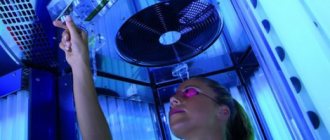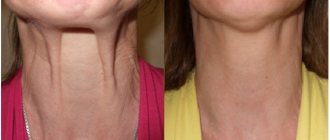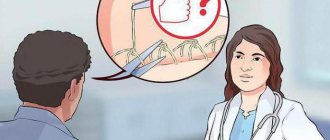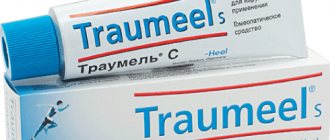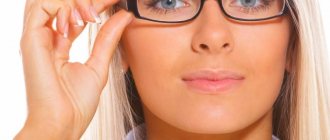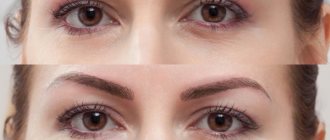The principle of action and effectiveness of Botox procedures
Botox began to be used for rejuvenation not so long ago. Initially, the drug was used to treat various diseases, such as strabismus.
Injecting Botox into the facial muscles completely relaxes them. The absence of contractions leads to the fact that existing wrinkles are smoothed out and new ones do not form.
Several brands of drugs are used in cosmetology. Do not be embarrassed if in one salon you are offered Dysport injections, and in another Botox or Xeomin. These are trade names. The active substance in all is the same - butulinum toxin type A.
The injections do not take long. This is why some women think that the procedure is “lightweight” and that special care after Botox is not needed. This misconception is not only wrong, it is dangerous.
How long after administration will the effect take place?
The drug takes a certain time to work; the effect of the injection will not become noticeable a few minutes after it is administered.
To properly distribute under the skin and gain strength, Botox will need at least 24-48 hours.
The exact time when the drug begins to work depends on several factors:
- Treatment zones.
- Insertion depths.
- Concentrations of substances in the drug.
- Features of the body.
What should you avoid after the procedure?
The most important rule to follow after the Botox procedure is to never touch your face. Even if you are very curious to feel the skin, do not try to do this. You should not use any peelings or masks; it is better to postpone their use for several weeks. All these prohibitions do not mean that you need to completely give up washing your face; no, you just shouldn’t use overly aggressive facial cleansers.
If the procedure was carried out in the summer, you will have to refuse to visit the beach. Since direct exposure to sunlight and hot air can lead to negative consequences. Fans of visiting the solarium will also have to postpone their favorite pastime. It is necessary to give up going to saunas, baths, and even give up a relaxing hot bath.
Of course, the main prohibition after Botox injections is alcohol. In the first few weeks after the injection, it is strictly forbidden to drink absolutely any alcoholic beverages. Alcohol has a dilating effect on blood vessels, and this in turn can lead to improper distribution of botulinum toxin. As a result, bumps may appear under the skin, and the drug may no longer work on the muscles. But the worst thing that can happen when drinking alcohol after a Botox procedure is the development of a serious allergy, which can have a negative impact on your health. Recently, you can find information on the Internet that you can still drink alcohol after a Botox injection. You should not trust the experience of people who were simply lucky and did not suffer serious complications from drinking alcohol after Botox. It is quite possible that this is true and the person actually drank alcohol after the injection. But most likely this is just luck, and it is not a fact that someone else will be lucky as well. It is better not to risk your life and health and still refrain from drinking alcohol after the procedure. After all, experts put such a ban on it not without reason, and there really is a threat to health.
In addition to alcoholic beverages, it is important to avoid taking certain medications. The fact is that in the first 2-3 weeks it is worth doing everything possible so that the blood does not accumulate in one place and, as a result, hematomas do not form.
It is for this reason that the following drugs should never be taken:
- Analgesics (medicines that relieve pain);
- Antibiotics included in the tetracycline group;
- Aminoglycosides;
- Drugs that reduce tone;
- Drugs for the treatment of mental illness;
- Vitamins E and B.
If swelling appears on the face after the procedure, it is permissible to use special masks with a cooling effect.
They should be used very carefully. It is also not prohibited to use creams, tonics and even lotions
For the first 24 hours, it is recommended to avoid wearing makeup, and after this time, you are allowed to apply everyday makeup.
No effect
Botox injections are considered a safe rejuvenation technique. They do not cause allergies, necrosis and inflammation of tissues. Botulinum toxin is a poison, but in order for it to have a negative effect on the body, it is necessary to administer a very large dose, 30 times higher than the usual concentration of “beauty injection” products.
However, in some cases the result of the procedure does not please the client. The reasons for dissatisfaction can be different: lack of effect, too pronounced action (“frozen face”) or obvious negative changes.
A “mask” instead of a living face can result if the drug with botulinum toxin is injected in too large a dosage and too deeply. In addition, frequent repeated injections have this effect, because the muscles become depleted over time.
In any case, the effect of Botox is based on muscle paralysis, so all people who decide to undergo injections should be prepared for a weakening of facial activity. When the effect is categorically disliked, the effect of Botox can be neutralized with the power of taking broad-spectrum antibiotics. This can only be done under the supervision of a doctor.
For what reason might there be no result at all?
- Medical recommendations after injections were not followed.
- The patient is over 60 years old - due to a strong decrease in muscle and skin tone, Botox is not able to have a significant effect.
- Individual immunity to botulinum toxin is observed in humans, but it is rare (in 1-2% of cases).
- The doctor incorrectly calculated the dosage of the drug or it was stored incorrectly.
Let us consider in more detail the rules of behavior after the procedure.
The most important limitations of Botox procedures and why
Many women, and even men, who are preparing for anti-aging injections are concerned about what not to do after Botox injections. At first glance, it seems that there are too many prohibitions. But if you look into it, it turns out that some of them are relevant for the first time for hours or days, and the rest are not so overwhelming.
The main prohibitions after anti-aging injections:
- Lie down for the first few hours.
- Touch your face.
- Active physical activity.
- Exposure to elevated temperature.
- Drinking alcohol.
Restrictions after Botox injections are completely removed after 14-21 days. The rejuvenating effect lasts for years.
Restrictions in the first days
For the first time, the watch is prohibited from performing actions that provoke a rush of blood to the head. Increased blood circulation reduces the effectiveness of the procedure and provokes side effects.
This is due to the fact that butulinum toxin type A does not “harden” immediately. And with increased metabolic processes, it can move from the injection site to neighboring muscles. That is why the list of what is not allowed after Botox includes a ban on taking a horizontal position and exposure to elevated temperatures and physical activity.
Many women who are planning to rejuvenate themselves with injections are wondering how long they should not lie down after Botox. Typically the restriction lasts from 4 to 6 hours.
You cannot bend over as much after the procedure. When going to a session with a cosmetologist, wear comfortable shoes so that you do not have to bend over. As a last resort, you can put on your shoes while sitting on a chair, but your neck and head should remain upright.
Outside the law for the first time, two days and active articulation and facial expressions. They also provoke migration of the drug, which reduces the anti-aging effect and leads to improper distribution of the substance.
Some patients ask whether it is possible to make masks, apply creams or do makeup after Botox. The ban on such actions is three days.
Restrictions on taking a horizontal position last for the first hours. But sleep-related restrictions apply to the first 2-3 days. So you can sleep on your side on the fourth day, and on your stomach after 21 days.
Facial peeling
Any exfoliating procedures are prohibited for the first time after Botox injections. But after two or three weeks, experts recommend resorting to hardware peelings.
Laser – let’s say after 14 – 21 days. A diamond dermabrasion session can be visited after three or four weeks, as well as ultrasonic cleaning.
Why can’t you do hardware peels in the first week after Botox injection? Any mechanical impact on the skin will lead to migration of the drug, which will significantly worsen the appearance. Moreover, both laser and ultrasound have a deep effect.
Going to the bathhouse or sauna
High temperatures are contraindicated after anti-aging injections. It is forbidden to go to the bathhouse after Botox procedures. Hot air and water will warm up the muscles and increase blood microcirculation.
Because of this, the injected drug can be redistributed over the face and go beyond the treated areas. At best, this will reduce the effectiveness of the procedure and you will simply waste time and money. At worst, a sauna and steam bath for the first time days after Botox will lead to the following consequences:
- Disruption of the facial muscles.
- Facial asymmetry due to drug migration.
- Ptosis, the upper eyelid most often suffers from this.
A bath after Botox is allowed after 10 days. Remember, by violating the prohibitions of a cosmetologist, you jeopardize not only your attractiveness, but also your health.
A tan
After Botox injections, it is forbidden to visit a solarium or stay in direct sunlight for a long time. Ultraviolet light activates metabolic processes and blood circulation. And this may lead to uneven distribution of the administered substance. The restriction is valid for 10 days.
If you have Botox done in the summer, do not leave the house without a wide-brimmed hat. Try not to be outside too much during the hottest hours of the day.
Use of alcohol
When preparing for anti-aging procedures, three days before them it is forbidden to drink strong drinks. Also, after a Botox injection, you should absolutely not drink alcohol.
This is due to the following reasons:
- Increased blood circulation under the influence of alcohol will reduce the effectiveness of the procedure. Incorrect distribution of the drug is also possible.
- Botox that is not fully “fixed” can enter the bloodstream when the blood vessels are dilated due to the influence of alcohol.
- The combined effect of anti-aging substances and alcohol on the body increases the load on the liver.
Cosmetologists advise abstaining from intoxicating drinks for 7-14 days.
Summing up
According to experts, it is impossible to accurately predict how long it takes for Botox to take effect. Therefore, they target clients for 1-2 weeks. Although, if you follow all the recommendations and have a healthy lifestyle, according to patient reviews, the first results will be obtained faster.
You can see how wrinkles are smoothed out using a series of photos taken before, a week and a month after the procedure. If you simultaneously use high-quality cosmetics and properly care for your skin, the result can last up to 6-8 months after the first injection and up to 12 months after the second one.
How to speed up the removal of Botox
Complications from injections are rare and are the result of incorrect dosage or incorrectly selected injection points, calling into question the professionalism of the cosmetologist. Also, side effects may occur due to the patient’s fault if he did not adhere to the recommendations during the recovery period.
To eliminate side effects, you need to contact an experienced cosmetologist. He will not only select a rehabilitation program, but will also monitor the progress of the procedures.
Methods to speed up the removal of Botox:
- Facial massage - lymphatic drainage will help speed up blood flow, remove stagnation of lymph, activate metabolic processes, and therefore remove toxins.
- Physiotherapy - the most popular is microcurrent stimulation. Under the influence of electric current, neuromuscular connections are created, which allows the motor activity of the fibers to be restored.
- Taking hormonal drugs and antibiotics significantly accelerates the elimination of botulinum toxin. But the choice of drugs and dosage regimen are prescribed by the doctor, taking into account the patient’s medical history.
Average number of units and prices
Between the eyebrows
By introducing a diluted toxin into the bridge of the nose and between the eyebrows, a significant reduction or complete elimination of vertical expression wrinkles is achieved.
Often, due to the active reduction of the eyebrows, the wrinkles here are very deep, developing into creases with age. They require high concentrations of the drug.
On average, this small area will require 10-20 units of Botox. The total cost of the procedure will be about 4000–4500 rubles.
Forehead
The use of drugs based on neurotoxin helps in a short time to get rid of horizontal wrinkles, the appearance of which is responsible for the contraction of the occipitofrontal muscle.
To correct the forehead, you will need 15–30 units of Botox, approximately costing 5,000 rubles.
The gold standard for using Botox is the simultaneous correction of the forehead, bridge of the nose, between the eyebrows and the area around the eyes, which contributes to overall facial rejuvenation: the disappearance of facial wrinkles, smoothing of the skin, and the return of an open look due to slightly raised eyebrows. The approximate cost of such a procedure will be 15,000 rubles.
Unfortunately, botulinum toxic drugs cannot effectively combat deep age wrinkles. The elasticity of the dermis in the area where such creases form is significantly reduced.
Therefore, relaxing the corresponding muscles can help smooth the skin, but it will not completely eliminate deep wrinkles.
Possible Undesirable Consequences
With botulinum therapy, it is always possible to develop certain side effects, and eliminating the eyebrow area is no exception. All such consequences can be divided into two groups - nonspecific, that is, those that occur when Botox is administered to any part of the body, and specific specifically for the treatment of glabella wrinkles.
Nonspecific side effects include:
- Swelling, bumps, bruises, lumps, itching, sensations of a foreign body under the skin at the injection sites - these develop in approximately every tenth patient;
- Flu-like syndrome with sore throat and slight fever;
- Headache, the incidence of which is about 11%.
All these effects are temporary and disappear after 1-3 days.
Specific side effects are considered more serious:
- Ptosis, due to which the strip below 1 cm from the eyebrows is considered an anatomically dangerous zone;
- Excessive raising of the eyebrows, including only their distal edges;
- Violations of facial expressions, which no longer involve the entire area of the glabella and forehead;
- Facial asymmetry;
- Loss of sensation in the eyebrow area.
The problem with these effects is that they develop for the same reason as the target outcome, and therefore persist for the same duration. In some cases, they can be partially or completely eliminated through compensatory injections, but sometimes they persist for the entire duration of the drug.
Practice shows that such consequences are most often the result of mistakes by cosmetologists. Therefore, to reduce the risk, the procedure should be performed by an experienced doctor.
Another serious and dangerous consequence - allergies - develops relatively rarely and is quickly stopped by the administration of adrenaline or antihistamines. It is important to notice the manifestation of hypersensitivity in time and quickly take action.
Sometimes the patient’s body can give an allergic reaction to “beauty injections”, for example, in the form of a rash.
There are also myths and fears that an overdose or even a normal amount of Botox leads to the development of permanent swelling, “bloating” and disfigurement of the face. In fact, all the “horror stories” about Botox victims turn out to be fakes, using photographs of victims of filler overdoses.
General issues
What can replace Botox?
If you need an analogue, basically any other botulinum toxin. The first substitute for Botox was Dysport, which is almost as ancient and well studied. For a long time it was the only (and worthy) alternative to Botox. Read more about him here >>.
The next analogue of Dysport and Botox was the Chinese Lantox. It stayed on our market for several years, but the quality was unstable. Cosmetologists are tired of finishing it off and now few of their colleagues work on it.
Then Xeomin appeared. The only Botox substitute so far that can be stored without refrigeration at room temperature. On the one hand, it relieved the fears of cosmetologists - suddenly the drug was defrosted during transportation. But on the other hand, it opened a tendency to reduce the usual time frame for the effectiveness of toxins. Instead of the usual 6 months on the same dose, the majority had 4. Now we are accustomed to the fact that Botox and Dysport often give such results, but at first everyone was very surprised. Xeomin received the most conflicting reviews from cosmetologists. Some people liked the “mild” effect of the drug. Others call this softness weakness and do not like it.
Against the backdrop of these sad trends in the weakening of toxins, a Russian analogue of Botox and Dysport appeared - Relatox. There it stood as it should, reminding us of how the toxins stood before! Now about half of our patients are on Relatox.
Most recently, Korean Botulax received registration in the Russian Federation. The first reviews from cosmetologists are not bad, we’ll see how it performs in the future.
When choosing a Botox analogue, you need to take into account that the units of activity of the drugs are different. There are correction factors that allow you to transfer the dose of drugs from one to another. Unfortunately, they are very approximate, but with experience you learn to make corrections.
But if you need not an analogue, but an alternative to Botox, i.e. If you want to completely do without botulinum toxins, you need to clarify for what effect you are looking for a replacement.
Eyebrows can be raised with threads with notches, small wrinkles can be reinforced to some extent with soft fillers or smooth threads, and polished with peelings or a laser. The rest is operations.
We wrote about treatment options for hyperhidrosis here>>
But, as a rule, alternatives to Botox are always inferior in terms of ease of procedure, safety, and quick results.
Is it possible to inject Botox or Xeomin after Dysport?
Can. This applies to all botulinum toxins - they are interchangeable, only the doses need to be recalculated - the units of Botox and Dysport are different. Try to write down not only the number of units, but also the name of the drug! If you have to change cosmetologist, this information will be very helpful for him the first time.
When does Botox take effect after injection?
The first effect of Botox occurs 2-3 days after the procedure in ~60% of cases, in 10-15% it is felt the next day, and in the remaining cases it gradually appears over the first week. In addition to individual sensitivity and the dose of the drug, the injection site affects the forehead, upper lip, and corners of the mouth in one person and may react on different days.
But relaxation of the muscles into which the drug was injected is only the beginning of the effect; the effect does not end there. Neighboring muscles not injected with Botox begin to react to the fact that their neighbors have lost tone. At first they pull the skin over themselves, then they get used to it and let go a little. This can be clearly seen by the height of the eyebrows - first a sharp rise and a desire to “slow down”, and then a calmer elevation.
All this constitutes a staged reaction, and ends by 12-15 days.
How long does it take to get Botox injections?
The answer follows from the previous one. It is necessary to finish pricking when the result of the procedure is visible, i.e. In 2 weeks.
Is it possible to get Botox injections earlier? If there is no time at all, then sometimes we reduce it to 7 days (for example, a person leaves and then there will be no opportunity to finish the injection). But only if it is clear that the dose was definitely not enough. We HIGHLY do not recommend lowering “fluttered” eyebrows before 2 weeks.
Is it possible to get Botox a third time?
Can. Sometimes they don’t guess the dose the first time, sometimes they deliberately do it in different stages. It’s okay - if the dose is not enough to achieve the desired effect, add it calmly.
By the way, if the corrections are not as massive as the first injection (fewer injection points and a smaller dose), then it is no longer necessary to wait 2 weeks before the next correction; a week is usually enough to draw conclusions.
According to statistics
It is almost impossible to answer unambiguously the question of how long it takes for the results of Botox preparations to become clearly visible - all this is very individual. There are only average statistical data that patients and cosmetologists rely on:
- the first results appear on days 3-7;
- the effect is clearly visible – after 2-3 weeks;
- maximum impact is a month after injections.
Some of the analogues of the original drug show a visible effect faster, but in general, with proper administration and the absence of serious complications or individual intolerance, they all work approximately according to this scheme.
What is not prohibited after Botox injections?
Many patients, on the contrary, turn out to be too cautious and impressionable, and therefore are afraid of even things that are not contraindicated after Botox and are completely acceptable.
For example, the results of the procedures will not be affected in any way by:
- Smoking. Although here we can repeat the hackneyed truth - smoking is harmful to health in general. This harmful habit will not add either beauty or health;
- Take vitamins and vitamin-mineral complexes, including specialized preparations of B vitamins. They have little effect on blood circulation and the pharmacokinetics of botulinum toxin;
- Just normal moderate physical activity - walking in the fresh air, for example. There is no clear opinion about swimming in cold water: on the one hand, cold water stimulates a reduction in the lumen of blood vessels and a weakening of metabolic processes in the skin, on the other hand, swimming is a direct violation of the ban on a horizontal position of the body. Therefore, for complete safety, you should refrain from swimming for at least 2-3 days;
- Air travel, water travel. Although here you need to take into account the duration of such a voyage - if you need to fly by plane to the other side of the planet for 8-10 hours, then such a flight itself will definitely not give vigor to the body and freshness to the face, and after botulinum therapy it can provoke the appearance of edema;
- Drink tea and coffee, not hot and in moderation. These drinks themselves do not affect the result of botulinum therapy, but simply a large amount of them (especially before bedtime) can provoke the appearance of edema, which, in turn, can cause side effects from botulinum therapy. But hot tea and coffee can promote active sweating, warming up the skin and facial muscles, which can ultimately negatively affect the absorption of botulinum toxin by nerve cells.
We must not forget a simple rule: it is better to ask any questions about what can and cannot be done after Botox directly to the doctor who injected Botox. This doctor is responsible for the result of the procedure, and therefore will allow or prohibit certain liberties as responsibly as possible. Moreover, this specialist will take into account the individual characteristics of a particular patient, the dose of botulinum toxin administered, and the general history of procedures.
Myths and reality of botulinum therapy
- What to do after Botox: recommendations for the next few days after the procedure
- About the compatibility of Botox and alcoholic beverages
- Is it possible to inject Botox during menstruation?
Preparing for the procedure: 3 simple but important rules
Botulinum therapy in general and injections into the eyebrow area in particular are quite safe and simple procedures for the patient. They do not require any special preparation, but you should still do something before going to the cosmetologist. Namely:
- Make an appointment at least a week in advance and find out which medications should not be taken before Botox injections. This is very important - certain medications can affect the result of botulinum therapy, but patients become so accustomed to using them that they do not even consider them to be anything significant;
- On the day of the procedure, get a good night’s sleep so that after the injections you don’t want to lie down and sleep for at least 3-4 hours;
- Do not drink alcohol before botulinum therapy.
Before the botulinum toxin injection procedure, you should not drink alcohol.
If your health worsens on the day before the injections, it is better to cancel the procedure. The administration of botulinum toxin for infectious diseases is contraindicated due to possible complications.
Basic principles of administering botulinum toxin preparations for correction of cheekbones and lower face
When using botulinum therapy for the lower part of the face and neck area, accuracy in choosing injection points and selecting the amount of the administered drug is very important.
The accuracy of the injection sites for botulinum toxin and the correct dosage are very important when correcting the oval of the face.
First, injections into the orbicularis oris and masseter muscles require denervation of only individual muscle fibers, but not the entire muscle, in order to weaken it, but not completely immobilize it. Secondly, the amount and dislocation of the administered drug must correspond to the task of eliminating fairly minor defects, often caused by only part of a particular muscle.
Finally, when lifting the neck in the décolleté area, the doctor must take into account the individual location of the muscle cords, including during various facial movements. Since their location may vary somewhat from person to person, it is necessary to carefully study the anatomy of a particular patient and understand which muscles provoke a particular defect.
This task is especially difficult when assessing the influence of the neck muscles on the chin, the chin muscles on the marionette line, and the temporalis muscle on the cheekbones and cheeks. Not only is the distribution of this influence strictly individual, depending on the type of face, but many muscles can also influence each other. That is why it is advisable to choose a very experienced cosmetologist to carry out botulinum therapy in the lower part of the face.
Of these procedures, perhaps the simplest, both in terms of drawing up a schedule of injections and in selecting the amount of the drug, is injections directly into the chin to reduce its tuberosity or excess tension. Here, injections are made into the lower part of the mental muscle at a distance of about 4-5 mm from the central axis of the face on each side.
To reduce marionette lines and elevate the commissures of the mouth, injections are made into the lower portion of the depressor anguli oris muscle. The doctor selects the specific location of the drug injection point on each side by assessing the depth of the crease and the individual characteristics of the mouth, in particular, possible asymmetry of the lips at rest and during movement.
For Nefertiti lifting, injections are made along the edge of the lower jaw to the point where it intersects with the posterior cord of the subcutaneous muscle of the neck, as well as along the cord itself. The diagram in this case resembles a boomerang in shape. The doctor selects the number of points and the amount of drug to be administered into each of them individually. As a rule, the largest amount of botulinum toxin is injected into the fold of the “boomerang” at the intersection of the edge of the jaw and the muscle cord, and the smallest amount is injected at the distal points.
Injection sites for Nefertiti lifting are along the lower jaw and the posterior cord of the neck muscle.
The rings of Venus and vertical cords on the neck are removed by injections into the muscles adjacent to them, the contraction of which causes the corresponding creases to appear. For each specific wrinkle, the topical cause is studied, the doctor applies the appropriate marks, and then injects Botox or another drug to a depth corresponding to the volume of the muscle.
The most complex patterns of point placement are required for procedures designed to remove a double chin, correct the shape of the face, and narrow the lower jaw and cheekbones. Here the whole variety of factors influencing a specific defect is assessed, and if necessary, additional methods are selected - injection of fillers, lifting, skin rejuvenation.
The technique for administering botulinum toxin to the lower part of the face and neck is practically no different from that for botulinum therapy of the upper part of the face. The solution is injected using thin needles, allowing the skin to be pierced almost painlessly, and the puncture is carried out at an angle to the surface of the skin. The doctor selects the depth of drug administration independently, taking into account that Botox injected into the subcutaneous tissue has a less pronounced effect than the drug injected directly into the muscle fibers.
The amounts of drugs injected can vary greatly depending on the defects being treated and the muscles being injected. If a lumpy chin can be removed with 4-6 units of Botox, then it is sometimes necessary to comprehensively rejuvenate the neck and décolleté area with 30-40 units of the same. Naturally, when using Dysport, the number of units will be even greater. The price of the procedure depends on the volume of the drug used and the complexity of the procedure - from 1,200 rubles for smoothing a tense chin to 8,000-10,000 rubles for a complete treatment of the lower third of the face and the formation of the “oval of Aphrodite.”
How good a result can be achieved with Botox injections between the eyebrows?
Botox injections can completely get rid of eyebrow wrinkles. After the procedure, the skin here is smoothed out and even with active facial expressions it practically does not wrinkle. The degree of expression of folds when expressing emotions can be varied to a certain extent by selecting a particular number of units of the product: a highly qualified cosmetologist can almost completely preserve facial expressions, but remove wrinkles at rest, or can achieve a complete absence of folds, regardless of emotions.
On a note
Many women strive at all costs to completely remove wrinkles in the area of the glabella, so that they are not visible either in a calm state or when expressing emotions. This is a rather dangerous desire: a typical consequence of the corresponding procedure will be a violation of facial expressions and the formation of a so-called “wax mask”. At the same time, emotions seem to be manifested, but their unnaturalness is very noticeable to the interlocutor, even if he sees the person for the first time after such an “excessive” procedure. Therefore, in most cases, it is advisable to choose a middle ground in which wrinkles between the eyebrows can appear when frowning, expressing feelings of disgust, surprise, but are absent when the face is calm.
For example, in the photo below is an example of eliminating a fairly deep wrinkle between the eyebrows:
The photographs were taken with a time interval of 6 days.
A similar result, but with a few wrinkles, is shown here:
And in this photo you can see the effect of botulinum toxin injections immediately in the area between the eyebrows and in the forehead:
Since wrinkles on the forehead are also formed due to the constant contraction of facial muscles, Botox is just as effective in removing them.
Review
The first time I injected Dysport, I was 30 years old. I was very pleased with the result, and now I went for Botox. Everything is the same, the injection technique is the same, the same thin needle, no differences. True, the injections hurt a little, but the pain was tolerable. The dosage of Botox is lower, so I needed a total of 40 units for the eyebrows, crow's feet and around the mouth, and Dysport was given 85. Either my skin structure is the same, or my facial expressions are too pronounced, but Botox only started working on the third day, and fully manifested itself only after a week. But how it worked! To say that I am happy means to say nothing! It’s as if five years have disappeared from my face; I didn’t look so fresh in my 20s. Everything is clean, not a single wrinkle anywhere, even small purse-string wrinkles are gone. It took effect in the area between the eyebrows almost immediately, the skin was completely smoothed out, and it appeared around the eyes in about a week. Plus, a bruise remained in one place for almost five days. I have this bruise - the only drawback of this whole procedure, I had to cover it up every day. But now I’m beautiful, I can’t look at myself in the mirror. Based on my experience with Dysport, this whole thing lasts for six months, the doctor said that Botox will work for a longer period. Let's see, in general.
Ekaterina, Moscow
It is noteworthy that situations where Botox would not help get rid of wrinkles between the eyebrows are very rare. This is due to the principle of its action: when a botulinum toxin drug (and it doesn’t matter, Botox, or its analogue, for example, Dysport) is injected into a muscle that, when contracted, forms a wrinkle, this muscle completely or a certain part of its fibers goes beyond the control of nerve cells . Normally, nerve impulses coming through these cells cause muscle contraction, which, in turn, leads to wrinkling of the skin. After botulinum toxin, the active ingredient of Botox, enters the muscle fiber, the nerve impulse is interrupted at the point of contact between the neuron and the myocyte (muscle cell), and the cell itself does not react in any way to the signal from the brain. Consequently, the muscle either completely or partially does not contract, does not compress the skin and the wrinkle does not appear, or appears to a lesser extent.
An experienced cosmetologist can inject the drug into the muscle so expertly that it will force it to contract exactly to the required extent. Without such fine work, the muscle simply stops contracting entirely. In this case, the wrinkle also disappears, but facial expressions are also disturbed.
Therefore, no matter how deep the wrinkle is, Botox will eliminate it in any case. The depth of the wrinkle is determined by the size and strength of the muscle causing it, and if this muscle is denervated, the wrinkle will disappear, no matter how noticeable it may be.
All this means that Botox will not work in only two cases:
- The doctor inserted it incorrectly and “missed” the muscle, the contraction of which leads to the appearance of this particular wrinkle;
- The patient is insensitive to botulinum toxin drugs.
Both cases are very rare. Only a completely untrained cosmetologist can “miss” a fairly large and easily palpable muscle in the area between the eyebrows - such people are simply not allowed near patients in clinics. And insensitivity to botulinum toxin occurs in no more than 5% of patients, including those who have previously had botulism. All this means that the wrinkle between the eyebrows can almost always be completely removed.
Statistics say that only about 5% of patients are not sensitive to botulinum toxin.
This is interesting
The cosmetic effect of botulinum toxin preparations was first discovered with injections in the area between the eyebrows. This happened by accident: Botox was then called Oculinum and was used to treat blepharospasm - a constant spastic contraction of muscles that led to severe facial distortions. One of the doctors who performed this treatment noticed that in a patient who received the drug near the eyebrows, in addition to the main effect, the wrinkles between the eyebrows were smoothed out. He reported this observation in an article, and this moment can be considered the beginning of the worldwide “Botoxomania” - in less than 20 years, the drug turned from a highly specialized product into a cosmetic bestseller, and the company producing it from a small private enterprise into a multi-billion dollar corporation.
It is also useful to read: Botulax - the Korean analogue of Botox
Carrying out the procedure
In order for Botox between the eyebrows to have the desired effect, you must carefully choose the dosage. Typically, the acceptable rate is from 8 to 20 units for the entire treated area.
Your doctor may start with a small amount in each injection and then monitor the reaction for several weeks. If the effect is not sufficiently pronounced, additional injections are given.
As a rule, the result of the procedure lasts 3-4 months, in some cases – six months. But only if it is carried out correctly and the technique is followed. The specialist determines how many units of Botox need to be injected onto the forehead, individually, depending on the severity and number of creases.
Preparation
At this stage, the specialist conducts a consultation to determine the condition of the skin, the presence of indications and contraindications for the procedure. To do this, the following points are clarified during the survey:
- Is the client using aminoglycoside antibiotics (may increase the effect of botulinum toxin), chloroquine and hydroxychloroquine (reduce the effect), warfarin or aspirin (promote poor blood clotting, bruising).
- Have you ever had an allergy attack (for example, after eating honey, a bee sting).
- Does the client have an individual intolerance to additional components of the drug?
The cosmetologist also talks about the features of the procedure: possible adverse reactions, complications, recommendations during the rehabilitation period. And only after that he starts injections.
Technique of drug administration
Tiny amounts of the toxin are injected directly into the muscles. Three to five small injections are required between the eyebrows to smooth out the line. Botox is injected between the eyebrows almost painlessly.
The technique is as follows:
- The cosmetologist asks the client to make a face to mark the injection points for the drug.
- The standard injection area is 2 centimeters from the eyebrow. It is outlined with a marker.
- The skin is disinfected. Anesthetic ointment is applied to the injection points to prevent pain.
- Botox is injected with a very thin needle to a depth of 7 millimeters at an angle of 45 degrees.
- The injection sites are gently massaged to distribute the drug evenly.
On average, correction takes 40-50 minutes. After this, the client remains under the supervision of a specialist for approximately the same time. If no side effects occur, he is sent home.
Rehabilitation
The recovery period is about 2 weeks. During this time, the client must comply with the following rules:
- Avoid alcoholic beverages. Alcohol increases blood circulation. The drug is absorbed twice as fast, so the result of the procedure may be less intense or even unnoticeable.
- No smoking. Nicotine slows down regeneration.
- You can't get vaccinated because your immune system is weakened by toxins.
In addition, it is not recommended to bend over, grimace too much and put physical strain on the body. Avoid visiting a bathhouse or sauna, and do not take a hot shower. All this can reduce the effect of treatment to zero and even cause serious complications.
Side effects
Botox injections are considered safe. And yet they can cause some unwanted reactions in the body:
- hematomas;
- pain;
- swelling at injection sites;
- asymmetry;
- drooping eyebrows;
- eyelid ptosis;
- bumps at the injection site;
- impaired mobility of facial muscles;
- severe itching;
- nausea, dizziness.
The body's standard reaction to botulinum toxin is mild redness and a slight migraine. These side effects go away within a few hours and do not require professional intervention. If they do not disappear within 3-4 days, you should definitely consult a doctor.
How to renew
Immediately after administration of the drug, the patient feels an unpleasant burning sensation and like goosebumps under the skin. But these feelings pass pretty quickly. Mild redness and swelling then appear for a few hours. They usually go away by the end of the second day.
But to get the maximum result from the procedure, you will have to follow some precautions for at least another week:
- avoid too active facial expressions;
- quit smoking and alcohol;
- do not take antibiotics and hormonal drugs;
- do not sunbathe or visit a solarium;
- do not steam your face or take a bath;
- do not massage or touch problem areas with your hands;
- do not perform hardware salon procedures;
- do not actively engage in sports;
- do not overheat and avoid temperature changes.
It is advisable to treat puncture sites with an antiseptic for at least two to three days until they are completely healed.
Botox and bad habits
Self-care after Botox includes not only restrictions on sports, but also on bad habits.
The second common bad habit - smoking - also has a bad effect on the condition of the skin. Nicotine constricts blood vessels, slows down the effect of the drug, and during the rehabilitation period prolongs the time during which adverse factors can affect the face. Therefore, the less the patient smokes, the longer he will maintain his beautiful appearance.
Is it possible to drink coffee, sleep little and do you need to follow a regime? During the rehabilitation period - necessary. Coffee, like alcohol, retains water in the body, contributing to the development of edema. Lack of sleep is dangerous not only due to bags under the eyes, but also due to impaired distribution of the drug on the forehead. Therefore, it is advisable to follow a routine and restrain yourself in your love of coffee and late-night gatherings.
Precautionary measures
Before the procedure, a consultation with a doctor collecting the patient’s medical history is required.
The importance of this stage should not be underestimated; additional tests may be required to identify hidden conditions. It is easier to prevent side effects than to correct aesthetic defects later
Contraindications:
- pregnancy, lactation period;
- chronic diseases;
- damage to the integrity of the skin;
- carrying out drug treatment, taking antibiotics;
- epilepsy;
- pathologies of the endocrine, nervous, circulatory system;
- infectious diseases, fever, high temperature;
- individual intolerance;
- diabetes;
- menstruation;
- postoperative period.
Possible complications usually appear in the first week after the procedure. But even unforeseen phenomena go away on their own, since the toxin is completely eliminated from the body. There may also be discomfort that does not affect the aesthetic result:
- pain in the injection area;
- hematomas;
- swelling;
- headache;
- dizziness;
- tearfulness.
Side effects:
- spasms of the eyelids;
- asymmetry, displacement of the eyebrow line;
- ptosis - drooping of the eyelid, up to complete closure of the eye;
- feeling of double vision;
- absence or decreased effect due to destruction of the toxin by antibodies of the immune system.
Contraindications
Main contraindications to “beauty injections”:
- take antibiotics, hormones and anticoagulants;
- blood diseases, which are accompanied by deterioration of blood clotting;
- pathologies associated with impaired transmission of nerve impulses;
- dysphagia – a disorder of the swallowing reflex;
- acute period of any disease;
- inflammatory process, wound or rash at the treatment site;
- pregnancy and lactation.

